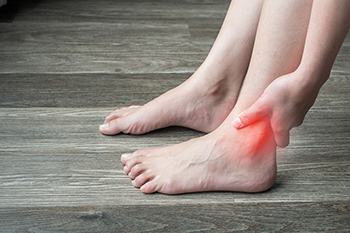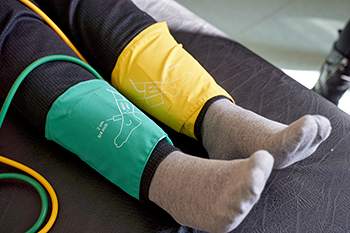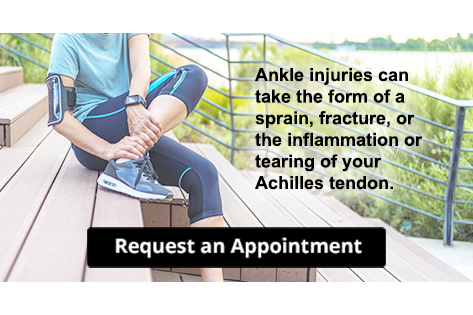
Ankle osteoarthritis, a degenerative joint condition, often stems from various factors, including trauma such as ankle fractures and chronic cell death. When an ankle fracture occurs, it can disrupt the normal alignment and function of the joint, leading to accelerated wear and tear on the cartilage, a cushioning tissue that covers the ends of bones. This increased stress can trigger the development of osteoarthritis over time. Chronic cell death, also known as apoptosis, can contribute to the breakdown of joint tissues in the ankle. Factors including aging, genetics, and repetitive stress can induce apoptosis in the cartilage cells, compromising their ability to maintain healthy joint function. If you have chronic ankle pain, it is suggested that you schedule an appointment with a podiatrist for treatment that can provide relief.
Arthritis can be a difficult condition to live with. If you are seeking treatment, contact Mark Majeski, DPM from Main Street Foot & Ankle, LLC. Our practitioner can provide the care you need to keep you pain-free and on your feet.
Arthritic Foot Care
Arthritis is a term that is commonly used to describe joint pain. The condition itself can occur to anyone of any age, race, or gender, and there are over 100 types of it. Nevertheless, arthritis is more commonly found in women compared to men, and it is also more prevalent in those who are overweight. The causes of arthritis vary depending on which type of arthritis you have. Osteoarthritis for example, is often caused by injury, while rheumatoid arthritis is caused by a misdirected immune system.
Symptoms
- Swelling
- Pain
- Stiffness
- Decreased Range of Motion
Arthritic symptoms range in severity, and they may come and go. Some symptoms stay the same for several years but could potentially get worse with time. Severe cases of arthritis can prevent its sufferers from performing daily activities and make walking difficult.
Risk Factors
- Occupation – Occupations requiring repetitive knee movements have been linked to osteoarthritis
- Obesity – Excess weight can contribute to osteoarthritis development
- Infection – Microbial agents can infect the joints and trigger arthritis
- Joint Injuries – Damage to joints may lead to osteoarthritis
- Age – Risk increases with age
- Gender –Most types are more common in women
- Genetics – Arthritis can be hereditary
If you suspect your arthritis is affecting your feet, it is crucial that you see a podiatrist immediately. Your doctor will be able to address your specific case and help you decide which treatment method is best for you.
If you have any questions, please feel free to contact our office located in Toms River, NJ . We offer the newest diagnostic and treatment technologies for all your foot care needs.

Peripheral artery disease, or PAD, is a condition characterized by narrowing or blockage of the arteries, typically in the legs, due to the buildup of fatty deposits. This restricts blood flow to the limbs, affecting the feet and causing various symptoms. Those at risk include smokers, diabetic patients, individuals with high blood pressure or cholesterol, and those with a family history of cardiovascular disease. Symptoms may include leg pain, cramping, numbness, weakness, or coldness in the feet and legs, especially during physical activity. However, some people with PAD may not experience any symptoms, a condition known as asymptomatic PAD. A podiatrist evaluates PAD through a comprehensive consultation, which may include assessing symptoms, and medical history, and performing tests like ankle-brachial index measurements or Doppler ultrasound to determine blood flow. Treatment focuses on managing symptoms, improving circulation, and reducing the risk of complications through lifestyle changes, medications, or surgical interventions. If you suffer from foot symptoms of PAD, it is suggested that you schedule an appointment with a podiatrist for care.
Peripheral artery disease can pose a serious risk to your health. It can increase the risk of stroke and heart attack. If you have symptoms of peripheral artery disease, consult with Mark Majeski, DPM from Main Street Foot & Ankle, LLC. Our practitioner will assess your condition and provide you with quality foot and ankle treatment.
Peripheral artery disease (PAD) is when arteries are constricted due to plaque (fatty deposits) build-up. This results in less blood flow to the legs and other extremities. The main cause of PAD is atherosclerosis, in which plaque builds up in the arteries.
Symptoms
Symptoms of PAD include:
- Claudication (leg pain from walking)
- Numbness in legs
- Decrease in growth of leg hair and toenails
- Paleness of the skin
- Erectile dysfunction
- Sores and wounds on legs and feet that won’t heal
- Coldness in one leg
It is important to note that a majority of individuals never show any symptoms of PAD.
Diagnosis
While PAD occurs in the legs and arteries, Podiatrists can diagnose PAD. Podiatrists utilize a test called an ankle-brachial index (ABI). An ABI test compares blood pressure in your arm to you ankle to see if any abnormality occurs. Ultrasound and imaging devices may also be used.
Treatment
Fortunately, lifestyle changes such as maintaining a healthy diet, exercising, managing cholesterol and blood sugar levels, and quitting smoking, can all treat PAD. Medications that prevent clots from occurring can be prescribed. Finally, in some cases, surgery may be recommended.
If you have any questions, please feel free to contact our office located in Toms River, NJ . We offer the newest diagnostic and treatment technologies for all your foot care needs.

Hammertoe is a foot deformity where one or more of the smaller toes become bent at the middle joint, resembling a hammer. It typically occurs due to an imbalance in the muscles, tendons, or ligaments that normally hold the toe straight. Common causes include wearing ill-fitting shoes, foot structure abnormalities, and arthritis. People with hammertoe may experience pain, swelling, corns, or calluses on the affected toe. In severe cases, the toe may become rigid and difficult to move. Surgery may be necessary when conservative treatments like wearing proper footwear, toe exercises, or padding fail to provide relief. Good candidates for surgery include individuals with persistent pain, severe deformity, or difficulty walking. Those with poor circulation, an active infection, or other health problems must consider the risk of such surgery carefully. Surgery aims to straighten the toe, relieve pain, and restore function, often involving removing a portion of the bone or releasing tight tendons. If you have a painful hammertoe that has not responded to other treatments, it is suggested that you schedule an appointment with a podiatrist to see if surgery is the right solution for you.
Hammertoes can be a painful condition to live with. For more information, contact Mark Majeski, DPM of Main Street Foot & Ankle, LLC. Our practitioner will answer any of your foot- and ankle-related questions.
Hammertoe
Hammertoe is a foot deformity that occurs due to an imbalance in the muscles, tendons, or ligaments that normally hold the toe straight. It can be caused by the type of shoes you wear, your foot structure, trauma, and certain disease processes.
Symptoms
- Painful and/or difficult toe movement
- Swelling
- Joint stiffness
- Calluses/Corns
- Physical deformity
Risk Factors
- Age – The risk of hammertoe increases with age
- Sex – Women are more likely to have hammertoe compared to men
- Toe Length – You are more likely to develop hammertoe if your second toe is longer than your big toe
- Certain Diseases – Arthritis and diabetes may make you more likely to develop hammertoe
Treatment
If you have hammertoe, you should change into a more comfortable shoe that provides enough room for your toes. Exercises such as picking up marbles may strengthen and stretch your toe muscles. Nevertheless, it is important to seek assistance from a podiatrist in order to determine the severity of your hammertoe and see which treatment option will work best for you.
If you have any questions, please feel free to contact our office located in Toms River, NJ . We offer the newest diagnostic and treatment technologies for all your foot care needs.

